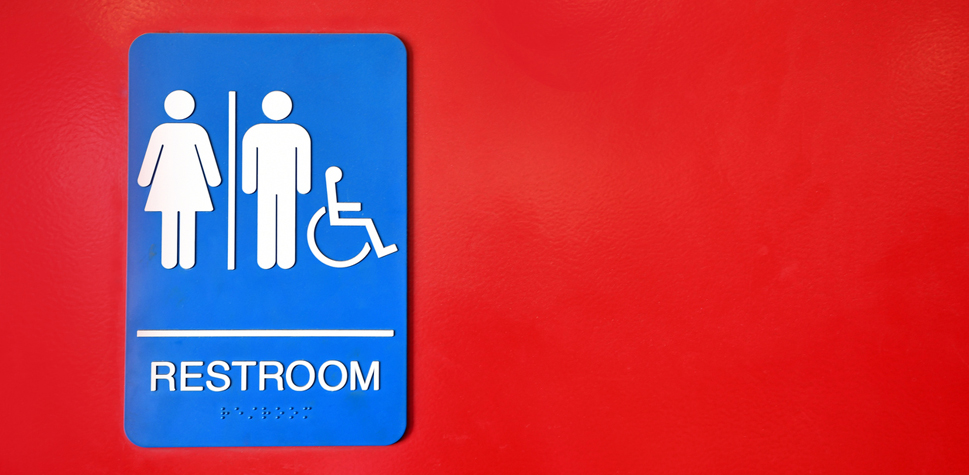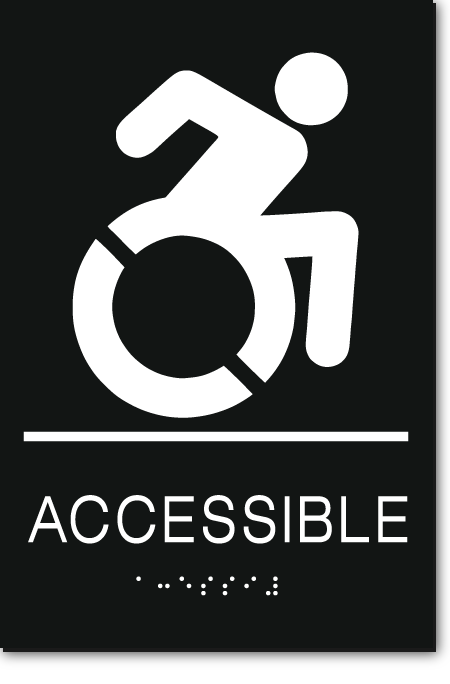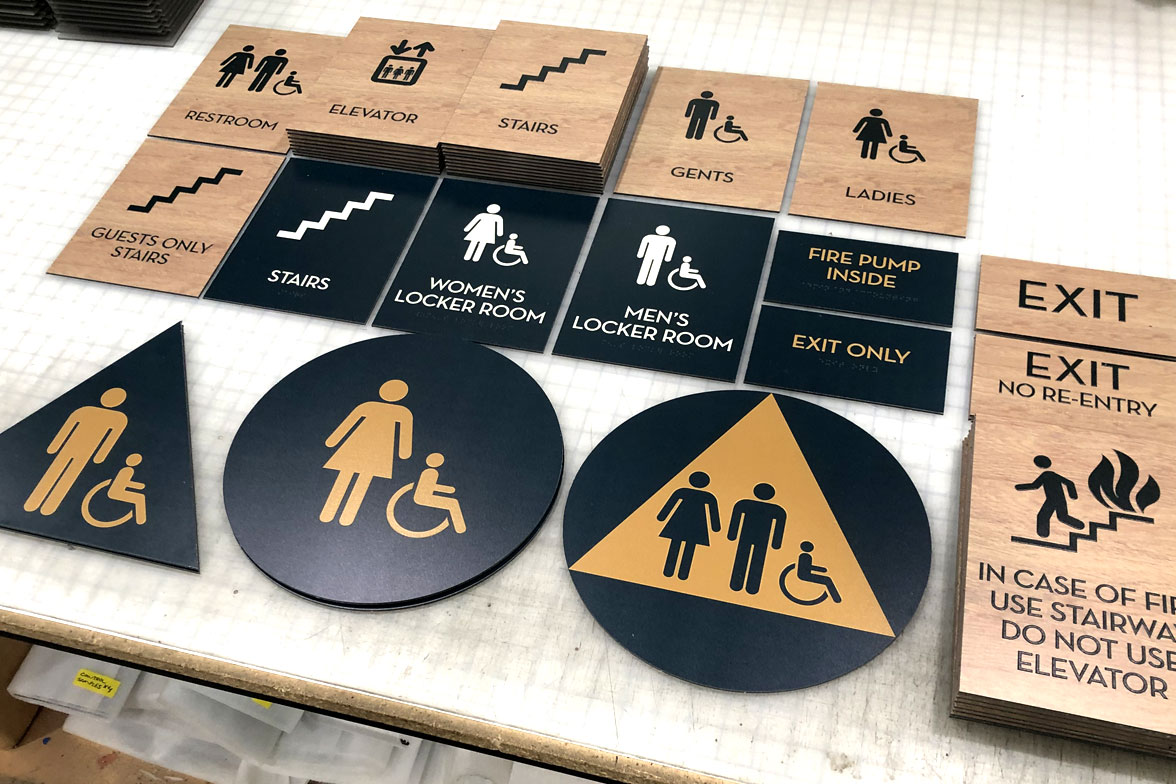The Impact of ADA Signs on Community Accessibility
The Impact of ADA Signs on Community Accessibility
Blog Article
Discovering the Secret Functions of ADA Indications for Improved Ease Of Access
In the realm of ease of access, ADA signs serve as silent yet powerful allies, making sure that spaces are inclusive and accessible for people with impairments. By incorporating Braille and tactile aspects, these signs break obstacles for the visually damaged, while high-contrast color plans and legible font styles provide to diverse visual demands.
Relevance of ADA Compliance
Ensuring compliance with the Americans with Disabilities Act (ADA) is important for fostering inclusivity and equivalent access in public areas and offices. The ADA, enacted in 1990, mandates that all public centers, companies, and transportation services fit people with impairments, guaranteeing they enjoy the exact same civil liberties and opportunities as others. Conformity with ADA criteria not just satisfies lawful responsibilities yet also improves a company's track record by demonstrating its dedication to variety and inclusivity.
One of the crucial aspects of ADA compliance is the execution of available signs. ADA signs are developed to ensure that individuals with handicaps can quickly navigate via spaces and buildings. These indications have to stick to particular guidelines concerning size, font, color comparison, and positioning to assure presence and readability for all. Properly implemented ADA signage aids remove obstacles that people with specials needs typically come across, consequently promoting their independence and self-confidence (ADA Signs).
In addition, sticking to ADA laws can minimize the threat of lawful consequences and prospective fines. Organizations that fail to abide with ADA standards may face fines or claims, which can be both damaging and economically troublesome to their public photo. Therefore, ADA compliance is important to fostering a fair setting for everybody.
Braille and Tactile Components
The consolidation of Braille and responsive components into ADA signage symbolizes the principles of availability and inclusivity. It is typically placed below the matching message on signs to make sure that people can access the details without aesthetic assistance.
Responsive components expand past Braille and consist of increased characters and icons. These elements are designed to be discernible by touch, enabling individuals to recognize space numbers, toilets, exits, and other crucial locations. The ADA establishes details guidelines regarding the dimension, spacing, and positioning of these tactile elements to maximize readability and make certain uniformity across different settings.

High-Contrast Color Design
High-contrast color pattern play a critical duty in improving the visibility and readability of ADA signs for individuals with aesthetic disabilities. These systems are necessary as they maximize the distinction in light reflectance between message and background, ensuring that indicators are quickly noticeable, also from a distance. The Americans with Disabilities Act (ADA) mandates using particular shade contrasts to fit those with limited vision, making it a vital facet of conformity.
The efficacy of high-contrast colors hinges on their ability to attract attention in different lights conditions, including poorly lit environments and locations with glow. Usually, dark message on a light background or light text on a dark history is employed to accomplish optimum contrast. Black text on a yellow or white history offers a stark visual distinction that assists in fast recognition and comprehension.

Legible Fonts and Text Dimension
When taking into consideration the layout of ADA signs, the option of readable typefaces and proper message size can not be overstated. The Americans with Disabilities Act (ADA) mandates that fonts have to be not italic and sans-serif, oblique, manuscript, very attractive, or of uncommon type.
The size of the text also plays a pivotal duty in availability. According to ADA standards, the minimum message elevation should be 5/8 inch, and it ought to increase proportionally with watching range. This is This Site especially important in public rooms where signage requirements to be read promptly and precisely. Uniformity in message size contributes Full Article to a natural visual experience, assisting individuals in browsing atmospheres efficiently.
Furthermore, spacing between letters and lines is important to legibility. Appropriate spacing avoids personalities from appearing crowded, improving readability. By sticking to these requirements, developers can substantially boost availability, ensuring that signage offers its intended function for all people, despite their aesthetic capabilities.
Efficient Positioning Strategies
Strategic placement of ADA signs is vital for optimizing accessibility and making sure conformity with lawful standards. Appropriately located signs assist people with disabilities successfully, facilitating navigation in public areas. Key considerations consist of closeness, height, and exposure. ADA standards state that indicators need to be installed at an elevation between 48 to 60 inches from the ground to ensure they are within the line of sight for both standing and seated people. This standard height array is critical for inclusivity, enabling image source wheelchair users and individuals of differing elevations to accessibility information easily.
Additionally, indicators have to be positioned beside the lock side of doors to enable simple recognition prior to entrance. This placement helps people situate areas and rooms without blockage. In instances where there is no door, indications must be located on the local surrounding wall surface. Uniformity in indication placement throughout a facility boosts predictability, reducing confusion and boosting total individual experience.

Final Thought
ADA indicators play an important duty in advertising ease of access by incorporating attributes that deal with the requirements of people with disabilities. Integrating Braille and responsive components ensures important details comes to the visually damaged, while high-contrast color pattern and legible sans-serif fonts improve exposure throughout numerous lights problems. Effective placement techniques, such as proper placing elevations and strategic locations, further help with navigation. These aspects collectively promote an inclusive atmosphere, highlighting the value of ADA conformity in making sure equivalent accessibility for all.
In the world of accessibility, ADA indications serve as quiet yet powerful allies, guaranteeing that spaces are inclusive and navigable for people with specials needs. The ADA, passed in 1990, mandates that all public facilities, companies, and transport solutions suit individuals with impairments, guaranteeing they appreciate the exact same rights and possibilities as others. ADA Signs. ADA indicators are developed to ensure that people with impairments can easily browse through spaces and structures. ADA guidelines stipulate that indications ought to be placed at a height between 48 to 60 inches from the ground to guarantee they are within the line of sight for both standing and seated people.ADA signs play an essential role in advertising ease of access by incorporating functions that resolve the requirements of people with impairments
Report this page